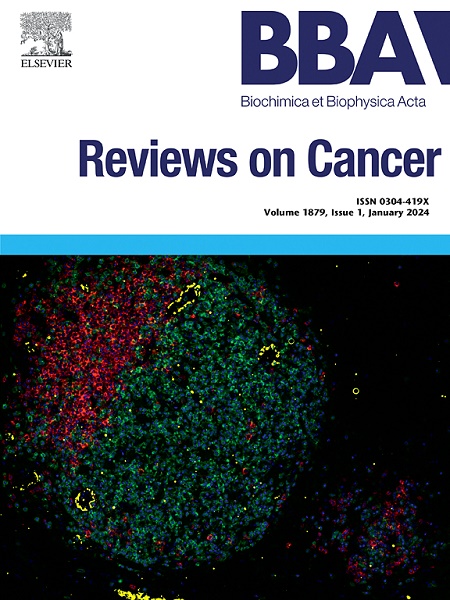Role and mechanism of IL-33 in bacteria infection related gastric cancer continuum: From inflammation to tumor progression
IF 9.7
1区 医学
Q1 BIOCHEMISTRY & MOLECULAR BIOLOGY
Biochimica et biophysica acta. Reviews on cancer
Pub Date : 2025-03-07
DOI:10.1016/j.bbcan.2025.189296
引用次数: 0
Abstract
Gastric cancer, a globally prevalent malignant tumor, is characterized by low early diagnosis rate, high metastasis rate, and poor prognosis, particularly in East Asia, Eastern Europe, and South America. Helicobacter pylori (H. pylori) is recognized as the primary risk factor for gastric cancer. However, the fact that fewer than 3 % of infected individuals develop cancer suggests that other bacteria may also influence gastric carcinogenesis. A diverse community of microorganisms may interact with H. pylori, thereby driving disease progression. Here, the role of the cytokine IL-33, a member of the IL-1 family, is scrutinized. Its production can be induced by H. pylori through the activation of specific signaling pathways, and it contributes to the inflammatory environment by promoting the release of pro-inflammatory cytokines. This article reviews the conflicting evidence regarding IL-33's role in the progression from gastritis to gastric cancer and discusses the potential therapeutic implications of targeting the IL-33/ST2 axis, with various antibodies and inhibitors in development or undergoing clinical trials for inflammatory diseases. However, the role of IL-33 in gastric cancer treatment remains to be fully elucidated, with its effects potentially dependent on the cellular context and stage of cancer progression. In summary, this review provides a comprehensive overview of the intricate relationship between gastric microbiota, IL-33, and gastritis - gastric cancer transition, offering insights into potential therapeutic targets and the development of novel treatment strategies.
求助全文
约1分钟内获得全文
求助全文
来源期刊

Biochimica et biophysica acta. Reviews on cancer
医学-生化与分子生物学
CiteScore
17.20
自引率
0.00%
发文量
138
审稿时长
33 days
期刊介绍:
Biochimica et Biophysica Acta (BBA) - Reviews on Cancer encompasses the entirety of cancer biology and biochemistry, emphasizing oncogenes and tumor suppressor genes, growth-related cell cycle control signaling, carcinogenesis mechanisms, cell transformation, immunologic control mechanisms, genetics of human (mammalian) cancer, control of cell proliferation, genetic and molecular control of organismic development, rational anti-tumor drug design. It publishes mini-reviews and full reviews.
 求助内容:
求助内容: 应助结果提醒方式:
应助结果提醒方式:


